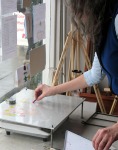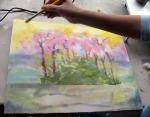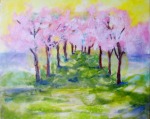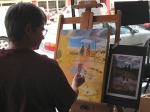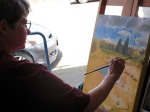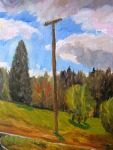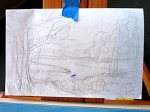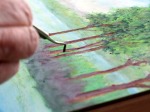Thanks to guest writer Christina Hugo for today’s post.
Today Carolynn Wagler helped to bring spring to Portland with a watercolor of warm, vibrant, orangey tulips. It was a fitting subject as we sat in the window of Muse safe from the intermittent April showers.
Carolynn came ready with a light graphite sketch of her design, which was from a photograph she had taken at a tulip festival a few years back. It was an image she had been saving, waiting to give it new life in paint. After a few touch-ups with her pencil to define her lines, which would be the map for her piece, she began by masking her whites. Carefully identifying any white detail in her color photo, she mimicked these areas with masking fluid to repel paint and maintain her tulips’soft white tips. The plump blooms were then washed with a wide, wet brush followed by a sweep of lemon yellow. Carolynn then used a blow drier to set the yellow, and already the strong effect of the masking fluid was evident. Bright yellow tulips with sweet white highlights now filled much of the page. She told me that as she added more color the masking fluid would be scrubbed away to blend the white naturally into the petals.
Crimsons, golden oranges, and bluish purples gave the blooms dimension, texture and richness . Thin upward strokes of color brought out the veins and spines of the petals, while a water-charged brush diluted color in other places to give contour and shading, bringing it all slowly to life.
Carolynn used a test palette of watercolor paper painted with her original yellow to see how each new hue would appear layered on the last. On this tiny watercolor laboratory she discovered, through trial, error, and inquisitive patience how to coax her perfect purple from a neutralizing yellow background.
Carolynn has been painting with watercolors for 11 years, but has experience with acrylics and pastel as well. She says watercolor is her favorite because of its fluidity. She says she finds it “a thrill to see what you come up with through the nature of the water and pigment together.” Carolynn’s portfolio is filled with landscapes in all seasons, and expressive faces which portray emotion through bright eyes and flowing features. She is looking forward to painting some of the tropical flora she captured on film during a recent trip to Hawaii. Carolynn teaches pastel painting through Portland Parks and Recreation and she is a member of the Portland Fine Arts Guild.
The last picture below shows Carolynn’s painting at the end of the day Monday (with watercolor paper still taped to board). We’ll post an update with a picture of the finished piece. UPDATE: The last picture below shows Carolynn’s finished painting.
Click on thumbnails to see larger pictures.







